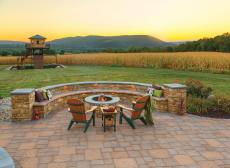You are here
Walls
There are various reasons why people want walls built. Some walls are for decoration, some are functional - like sitting walls, and others are necessary for structural reasons. No matter the reason, Kingdom Landscaping has the expertise when it comes to wall construction.
Check out our video below to see the many different styles of walls that we have installed:
Garden Walls
Usually marketed as “garden wall block,” these block walls are usually no taller than 16 inches. They come in “straight-face” or “tapered-face” style and are usually 4” thick. Common colors are gray, tan, brown or red, depending on the manufacturer. Garden wall block should never be used as a structural retaining wall system. These blocks are perfect for garden boxes or edgers around tree circles and landscape beds. Garden wall block is also
are usually no taller than 16 inches. They come in “straight-face” or “tapered-face” style and are usually 4” thick. Common colors are gray, tan, brown or red, depending on the manufacturer. Garden wall block should never be used as a structural retaining wall system. These blocks are perfect for garden boxes or edgers around tree circles and landscape beds. Garden wall block is also used in many firepit kits.
Natural dry-stacked stone can also be used for building garden walls. This adds a simple, yet natural look around any home, especially those in a country setting. There are also many options when choosing natural stone: Colonial Wall, Western Maryland, Pennsylvania Field Stone, Bluestone, etc. It is best to visit a local stone dealer and look at their palletized stone selection.
Double-Sided Sitting Walls
Sitting walls are non-load bearing walls. These are free standing; therefore, they need to be textured on both sides of the wall block. The standard thickness of this block is usually 3” and 6”. The standard height for a sitting wall is 21” total (including 3” of buried block).
Seat Walls
Sometimes people confuse the terminology of sitting wall and seat wall. The best way to differentiate between the two is that the seat wall has a back like a chair. Seat walls are obviously more expensive than sitting walls, because it requires the construction of two walls: one lower sitting wall (21”) and one higher back wall (36”). The sitting wall portion is also usually deeper than the seat on a sitting wall.
and seat wall. The best way to differentiate between the two is that the seat wall has a back like a chair. Seat walls are obviously more expensive than sitting walls, because it requires the construction of two walls: one lower sitting wall (21”) and one higher back wall (36”). The sitting wall portion is also usually deeper than the seat on a sitting wall.
Retaining Walls
Retaining walls are usually built to perform a specific function: retain dirt between different elevations. They fall into two categories: engineered and non-engineered.
An engineered retaining wall is a wall that has a 3’+ exposed height. Walls over 3’ tall require an architectural drawing with an engineer’s stamp in Maryland. They also require a fence directly behind the wall. In addition, the drawing will specify which layers of the block require geogrid, the type of geogrid required, and how far it needs to go into the bank behind the wall. These walls are also inspected by the engineering firm during construction. These walls are usually built with “commercial” grade block that are 8” x 18” and weigh up to 100 lbs. The largest engineered wall to date that Kingdom Landscaping has constructed was 13’ tall and approximately 75’ long.
Non-engineered walls are much more common. Most segmental retaining walls (SRW) use a pin, clip, or lug system and require SRW adhesive between each course. There are many different block styles, sizes, and colors to choose from. Many are what we call “multi-piece” systems that use up to five different lengths of block to make the wall look less manufactured. It is even possible to mix 3” and 6” block in one system for a more random look. Most SRW blocks can be used to build columns/pillars, steps, bars, outdoor kitchens, fireplaces, mailbox enclosures, and more.
